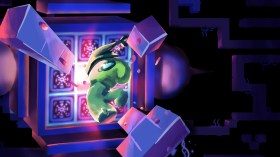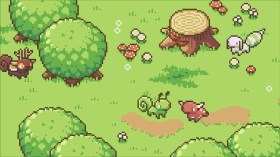Dear Me: quick links
It’s been 15 years since Cing – the beloved developer behind Another Code: Two Memories and Hotel Dusk: Room 215 for the Nintendo DS – closed. The studio produced several beloved titles, but it’s those two (and the Hotel Dusk sequel, Last Window) that have endured most strongly in the public consciousness. These were titles that made clever use of the Nintendo DS, featuring puzzles that made use of the system’s clamshell design and portable nature in unique, interesting ways.
Another Code and Hotel Dusk were also celebrated for their distinct visual styles, courtesy of director Taisuke Kanasaki.
Hotel Dusk, in particular, used rotoscoping to great effect: the pencil-sketch aesthetic, combined with the realistic movements and sparkling dialogue, gave the game a vibe that was entirely its own. Even last year’s Another Code remake for the Switch could not capture the original game’s magic: within Kanasaki’s original art and the constraints of the system, much of the spark was lost.
Dear Me: Kanasaki returns
Kanasaki did not leave the games industry after Cing’s collapse, but Switch 2 exclusive Dear Me, I Was… feels like a long-awaited return regardless.
It brings back the rotoscoped, hand-drawn style of Hotel Dusk, but with a very different philosophical approach compared to that game’s text-heavy, puzzle-driven detective work: interactivity is stripped right back, and the game, which takes 40 minutes to finish if you dawdle, is almost devoid of dialogue.
Watch the Dear Me, I Was… announcement trailer.
There’s no mystery here beyond the scope for interpretation: what we have instead is a small, lovely journey through the life of an artist.
Dear Me: a woman’s life
Dear Me, I Was… follows an unnamed woman’s life, starting at girlhood and spanning multiple decades, jumping between happy memories, formative moments of regret and tragedy, and other incidents that are imbued with some level of personal significance for her.
Across her life – which is not necessarily a remarkable or unusual one – the woman forms a complex relationship with art. This is reflected in the game’s visual style, which alternates between scratchy sketches and more fully-realised watercolour tableaus, often communicating emotional moments through colour and contrast rather than dialogue or action.

It’s the sort of story that makes you want to take a step back and consider your own life in more detail, but it’s not a story with trite or easy resolutions, nor simple, overly moralistic messages.
There’s a subtle complexity to the emotional palette the game is painting from, and enough ambiguity to ensure that each player can have their own unique experience with the work.
Dear Me: a game?
Dear Me, I Was… is a game by the strictest definition, but it’s a light one. Moments of interaction are marked by a hand marker on the screen, which can be controlled via controller, touch screen, or the Joy Con’s mouse mode.
You might click at a plate of food to eat its contents, scribble across a page to draw a sketch, or tap at the right point on the screen to advance a scene. Things never get more complex than that – there are no puzzles, no choices, no challenges.
This is not a criticism: Dear Me, I Was… is clear in its modest ambitions, and never feels compromised or constrained by how little there is to it. It’s a game that gives you something beautiful to hold in your hands and admire. It also has an ending that caught me completely off guard – without spoiling it, it takes its own rules and bends them gently to huge effect.
Great short stories – in games or otherwise – are often fundamentally mundane, imbuing ordinary moments with a level of scrutiny that elevates their importance. Games like A Short Walk, Wide Ocean Big Jacket, and Florence (perhaps the game I’d most directly compare to this one) elegantly tell small-scale stories about characters navigating their lives and emotions, and I find all of them quite affecting.
Dear Me, I Was… is cut from a similar cloth, but it’s going to carry a little extra depth of meaning for Kanasaki’s earlier work: it’s a game about the impact art can have on a person’s life from an artist whose work impacted many players over a decade ago.
Nothing excessively dramatic happens, although there are moments that feel surprising, or which invite deeper scrutiny.
Dear Me, I Was… has launched at a very low price point ($11), which feels appropriate for what is, essentially, a lightly interactive short film. It’s a gorgeous piece of work, and, right now, maybe the most visually gorgeous Switch 2 exclusive, even if it’s not pushing the hardware particularly hard.
Small as it is, Dear Me, I Was… is a lovely work that’s going to stick with me.
Dear Me, I Was… was released on 31 July 2025 and is available on the Nintendo Switch 2.
Discover more screen, games & arts news and reviews on ScreenHub and ArtsHub. Sign up for our free ArtsHub and ScreenHub newsletters.
Developer
Arc System Works
Publisher:
Arc System Works
Release Date:
31 July 2025





